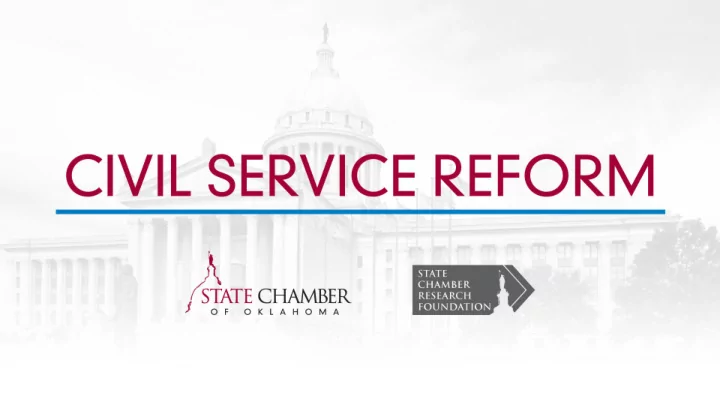

Mike Jackson Executive Vice President-Government & Political Affairs State Chamber of Oklahoma
BACKGROUND The State Chamber Research Foundation has contracted with the National Academy of Public Administration to conduct an extensive analysis of Oklahoma’s current civil service system and that of six other states.
CLASSIFIED SERVICE DEFINITION ▪ By definition, classified service encompasses state employees and positions under the jurisdiction of the Oklahoma Merit System of Personnel Administration ▪ There is no consistency across the agencies regarding which employees are classified
OVERVIEW OF OKLAHOMA’S CIVIL SERVICE SYSTEM
MAJOR CONCERNS WITH THE CURRENT SYSTEM ▪ The current system is bureaucratic and inflexible ▪ It prevents agencies from being able to effectively manage their workforce ▪ Agencies are unable to reward high-performing employees ▪ Dismissing poor-performing employees can be time- consuming and extremely costly to state government
CIVIL SERVICE REFORM AREAS ▪ Percentage of state employees that are classified ▪ Give state agency heads the authority to manage their agencies and use best HR practices ▪ Length of appeal process
TYPES OF ISSUES EMPLOYEES CAN APPEAL ▪ Oklahoma is the only state that allows state employees to appeal performance reviews ▪ All employees, both public and private, have employment protections under state and federal law
LENGTH OF APPEAL PROCESS Oklahoma’s Merit Protection Commission investigations are long and drawn out.
PERCENTAGE OF EMPLOYEES THAT ARE CLASSIFIED ▪ 65% of Oklahoma’s public employees are classified ▪ Each agency varies in regards to the size of their classified workforce
FY 2018 JOB CLASSIFICATIONS BY STATE AGENCY State Agency FY2018 Employee End Count Percent Classified Employment Security Commission 464 97.0% Department of Human Services 5,808 91.5% Department of Corrections 4,177 89.7% Cosmetology Board 14 85.7% Office of Disability Concerns 4 75.0% Dentistry Board 5 20.0% School of Science & Mathematics 51 5.9% Wildlife Conservation 338 0.0% Insurance Department 119 0.0% Health Care Authority 525 0.0% 69 agencies have 0% classified employees
TYPES OF REFORMS ▪ Eliminate the entire civil service system • Example: Texas (1985) ▪ Transition to an at-will system by grandfathering in current employees • Example: Georgia (1996) ▪ Reform the civil service system process, not the number of classified employees • Example: Tennessee (2012)
TEXAS ▪ Texas implemented its civil service system reforms in 1985 ▪ All state employees are at-will employees except a small number of federally funded state employees
GEORGIA ▪ Georgia implemented its civil service system reforms in 1996 ▪ Today, 98% of state employees are at-will
TENNESSEE ▪ Tennessee implemented its civil service system reforms in 2012 ▪ Retained the same number of classified employees and kept the appeal process in place, but reformed the process to be more efficient
Recommend
More recommend